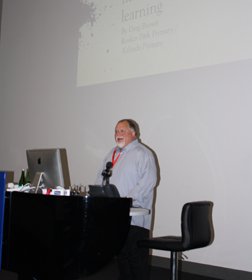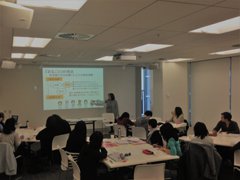3B in Australia
The Japan Foundation, Sydney
SAITO Mami, MITSUYA Mayumi, SUMA Ayuko
Bigger, Broader, Better! Japanese-Language Education in Australia
The nation of Australia is twenty times larger than Japan, but it is this vast size that makes it difficult for many people to gather in one place at the same time. This is true in the realm of Japanese-language education as well. Each of the six states, the one territory, and the Capital Territory have their own Japanese Teachers Association or equivalent organization, and normally those organizations function independently of each other. However, in order to overcome the various challenges facing Japanese-language education in this country, it is important for everyone, including those in primary, secondary, and higher education and others involved in Japanese-language education to work together. With that goal in mind, the National Symposium: Japanese Language Education (hereinafter “NSJLE”) was launched in 2012. The NSJLE is jointly hosted once every two years by the Melbourne Centre for Japanese Language Education and the Japan Foundation, Sydney. The first symposium in 2012 was the first time in 36 years that such an event was held on the national level, and it was reported that over 300 people participated from inside and outside Australia.

An activity report being given in a relaxed atmosphere. The presenters seem to be enjoying themselves as well.
A symposium on this scale might sound a bit daunting, but it encompassed all teachers in Australia involved in Japanese-language education, and the range of presentations given was quite diverse. For example, one presentation dealt with the serious issue of how to maintain the retention rate of Japanese language learners, while another proposed a competitive Karuta (playing card) game borrowing the idea from the Anime film Chihayafuru, and yet another reported on the degree to which a school’s Japanese program had improved through relations with their sister-school in Japan. Another that impressed me was that of a woman who traveled to Japan to study the language, fell in love with Sumo wrestling, and became a commentator. Her message that “language learning is a tool that connects one to the world and expands one’s potential” certainly is a message that resonates with anyone involved in language education.
The next symposium will be held in November, 2018 in Sydney with a theme of “Bigger, Broader, Better!” While this theme can mean many things, the primary image intended is for the further major development of the Japanese-language education network in Australia, and for the children learning Japanese in Australia to expand their horizons, learn about new worlds, and enjoy a bountiful future through their studies. I encourage you to also read the presentations from the seminar on the website (http://nsjle.org.au/). They may open up a new world for you as well.
Expanding the Marugoto Approach
The Japan Foundation, Sydney uses “Marugoto: Japanese Language and Culture” (hereinafter “Marugoto”), teaching materials based on JF Standard for Japanese-Language Education, for all Japanese classes from Starter to Intermediate level, and as we have mentioned in the previous reports, many of the students describe the classes as fun. The concept of Marugoto, which emphasizes finding what the student can do with the Japanese they learn through specific “Can-do” goals, apparently works well for Australian learners.
Accordingly, the center has held a series of seminars to introduce Marugoto, entitled “Expanding Classroom Effectiveness with Can-Do (Seminar for Japanese Language Teachers),” in Sydney, Brisbane, and Perth in order for Marugoto to be made more widely known. While it is certainly important to have the teachers see the Marugoto teaching materials, our primary focus was on the Marugoto approach in the form of the Can-Do system so that the teachers could understand our concept of bringing out the innate abilities of the learner. We also made videos of our Japanese-language courses at the Japan Foundation, Sydney to show our Marugoto classes during the seminar. We also designed the seminar to have the participants think for themselves what set our approach apart from the others. After presenting actual classes and have them gain insights, we moved on to Marugoto theory and online resources, resulting in a rich full day seminar.

The Marugoto seminar at the Japan Foundation, Sydney
The philosophy behind the development of Marugoto is mutual understanding between people through the study of the Japanese language and culture, which we believe is a very important approach for language learning. We presented the approach of using the ability to carry out tasks by applying learned Japanese skills as the key in a variety of learning situations and levels as one way to achieve that. Can-do can be applied to learning tasks irrespective of the teaching materials being used, so I feel that the seminar gave the participants an opportunity to imagine how to use the approach in their own classes.
Another important concept we communicated during the seminar was intercultural understanding. Learning of other cultures, taking an interest, and then taking action leads to rich cultural experiences and an intercultural understanding, which in turn cultivates an attitude of mutual cultural respect. And this approach is shared in common with the Australian curriculum (in Japanese) for primary and secondary education today. And the capacity for communication and intercultural understanding is of particular importance in a culturally diverse society like Australia.
So our seminar made the point that the Marugoto approach can be applied in some way to any classroom in Australia. I would be more than pleased if any part of the textbooks or online resources were put to use in the classroom.
- What We Do Top
- Arts and Cultural Exchange [Culture]
- Japanese-Language Education Overseas [Language]
- Japanese-Language Education Overseas [Language] Top
- Learn Japanese-language
- Teach Japanese-language
- Take Japanese-Language Test
- Know about Japanese-language education abroad
- The Japanese-Language Institute, Urawa
- The Japanese-Language Institute, Kansai
- Japanese-Language Programs for Foreign Specified Skilled Worker Candidates
- Japanese Language Education for Japanese Children Resident Overseas and for the Descendants of Migrants
- Archives
- Japanese Studies and Global Partnerships [Dialogue]
- JF digital collection
- Other Programs / Programs to Commemorate Exchange Year
- Awards and Prizes
- Publications
